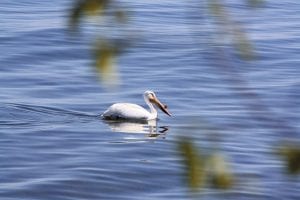Photo by Helen Boddy This American white pelican was seen in Grand Marais on Monday, June 15, a surprise to local birders who infrequently see the pelicans on their migration. Sadly, the bird was not in good health and perished before it could be taken to a wildlife rehabilitator. It is believed that it suffered from lead poisoning.

Local birders were first delighted, then saddened to see an American white pelican in the Grand Marais harbor on Monday, June 15. The bird was obviously in distress. Dave Ingebrigtsen of the Minnesota Department of Natural Resources (DNR) wildlife division was contacted. Seeing that the bird could hardly stay afloat, Ingebrigtsen contacted a wildlife rehabilitator in Garrison, MN. However, the bird died before it could be transported. Ingebrigtsen said from the bird’s symptoms, it is believed that it died of lead poisoning.
Ingebrigtsen said when he reached the pelican, it could hardly hold its head erect. He said the rehab specialist said only about 10% of the birds with such severe symptoms survive. According to the Minnesota Pollution Control Agency, a bird with lead poisoning will have physical and behavioral changes, including loss of balance, gasping, tremors, and impaired ability to fly.Theweakened bird is more vulnerable to predators, or it may have trouble feeding, mating, nesting, and caring for its young. It becomes emaciated and often dies within two to three weeks after eating the lead. According to local birder Molly Hoffman, it is not that unusual to see a pelican passing through our area. She said although they are not forest birds, they breed in Canadian prairie provinces, in North Dakota, and Western Minnesota. They winter in Mexico and further south, so their migration takes them to our harbor and other Lake Superior locations every year.
When Hoffman heard that the bird died, possibly of lead poisoning, she summed up the thoughts of many when she said, “How sad and unnecessary.”
It is probable that the pelican was exposed to lead by swallowing a lead fishing sinker or jig lost from a broken fishing line, either when scooping up food from the bottom of a lake or by eating a fish that had swallowed a sinker or jig.
Anglers can help prevent such lead poisonings by using ecologically sound alternatives to lead fishing weights. Anglers can use sinkers and jigs made from non-poisonous materials such as tin, bismuth, steel, and tungsten-nickel. Lead-free alternatives are available in all shapes and sizes from most fishing equipment retailers.
Ingebrigtsen said the bird would be sent to the Field Museum in Chicago, Illinois to be mounted and displayed.


Loading Comments